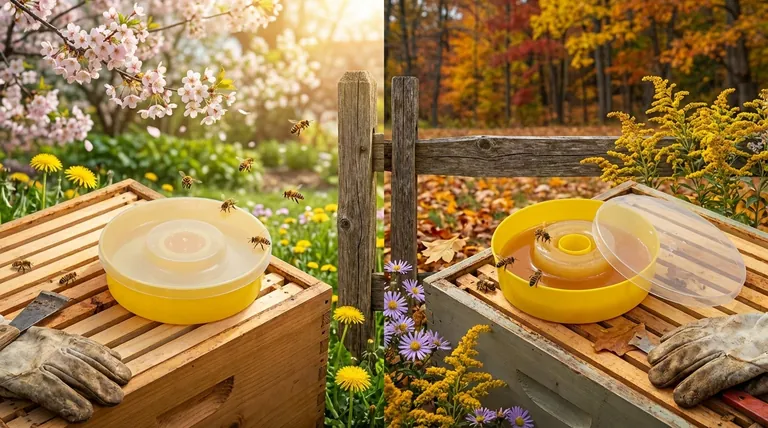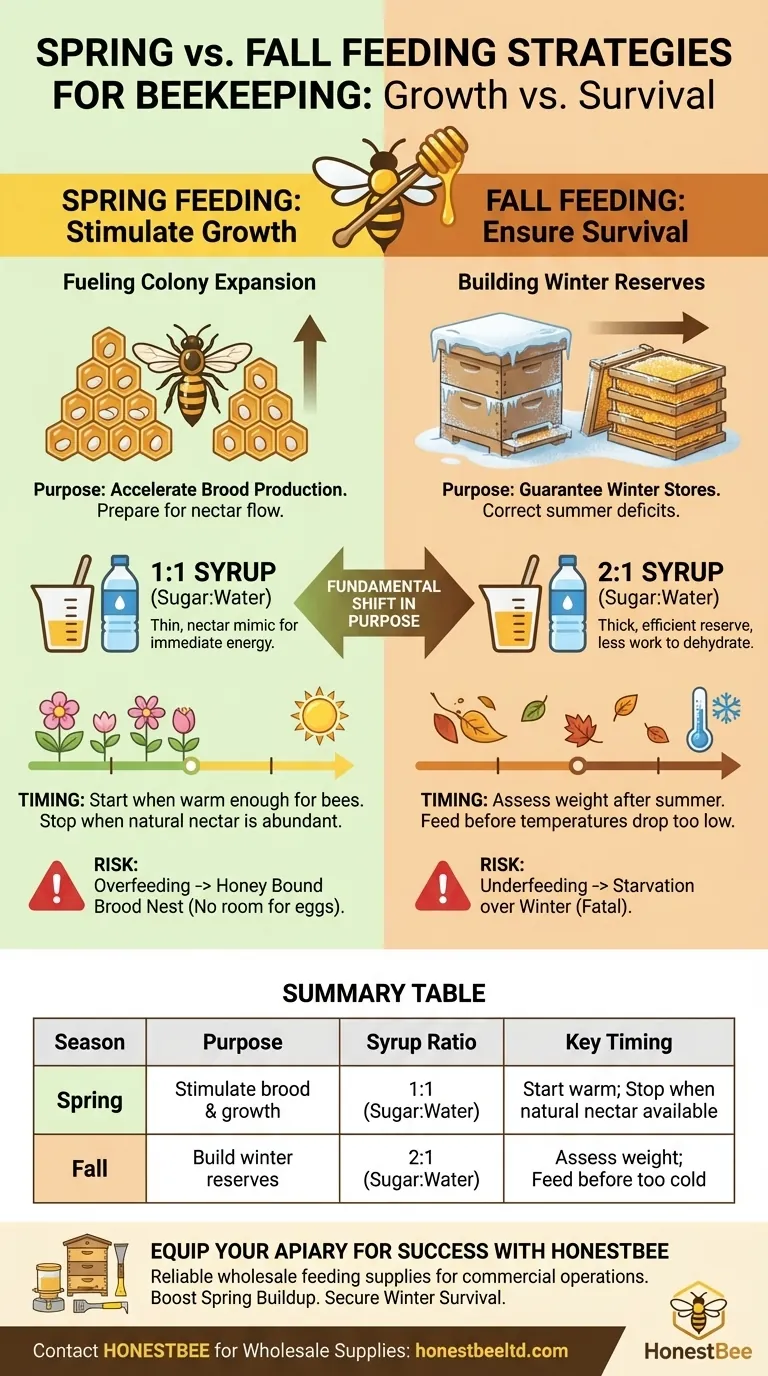The fundamental difference between spring and fall feeding is one of purpose. Spring feeding is a stimulant, designed to accelerate colony growth and prepare for the summer nectar flow. Fall feeding is a survival measure, intended to ensure the hive has enough stored food to make it through the winter.
Spring feeding acts as a catalyst for colony expansion before natural resources become abundant. Fall feeding, in contrast, serves as an essential insurance policy, guaranteeing the colony has the reserves needed to survive the dormant winter months.

Spring Feeding: Fueling Growth and Expansion
The goal of spring feeding is to simulate an early nectar flow. This encourages the queen to ramp up her egg-laying, leading to a rapid increase in the colony's population.
The Purpose: Stimulating Brood Production
A strong workforce is required to gather the main nectar flow of the season. By feeding in early spring, you are signaling to the queen that resources are plentiful, prompting her to lay more eggs and build that workforce before the peak blooms arrive.
When to Start and Stop
Begin feeding when temperatures are consistently warm enough for bees to take the syrup. You should continue until the bees have drawn out comb, there is some stored food in the hive, and, most importantly, natural nectar from blooming flowers becomes widely available. Once they can forage naturally, your job is done.
What to Feed: A Nectar Mimic
Typically, a 1:1 syrup (one part sugar to one part water by weight) is used in spring. This thinner syrup closely mimics the consistency of natural nectar, making it easy for the bees to consume and use as immediate energy for raising new brood.
Fall Feeding: Building Winter Reserves
In the fall, the focus shifts entirely from stimulation to survival. Your goal is to ensure the hive reaches a target weight, which indicates they have enough stored honey to last until the following spring.
The Purpose: Ensuring Survival
As natural nectar sources dwindle, the window for bees to stock their winter pantry closes. Fall feeding supplements their stores, correcting any deficits from the summer season and guaranteeing they have the calories needed to generate heat and survive the cold.
Assessing Your Hive's Needs
The decision to feed in the fall is based on a simple assessment: how much honey have the bees already stored? This is often determined by lifting the hive to gauge its weight. A light hive requires immediate and substantial feeding.
What to Feed: An Efficient Reserve
A 2:1 syrup (two parts sugar to one part water by weight) is the standard for fall. This thicker syrup requires less work for the bees to dehydrate and store as "honey" in the comb, which is critical as the days get shorter and colder.
Understanding the Critical Trade-offs
Feeding is a powerful tool, but improper use can harm the colony. Understanding the risks is as important as knowing the procedure.
The Risk of Overfeeding in Spring
If you feed too much, too early, the bees may fill the brood nest with syrup. This is known as the hive becoming "honey bound." It leaves the queen with no room to lay eggs, effectively strangling the colony's growth just when it needs to expand.
The Danger of Underfeeding in Fall
This is the most straightforward risk. A colony without sufficient honey stores will starve to death over the winter. There is no second chance once cold weather sets in permanently.
Why Timing Matters in the Fall
You must stop feeding before temperatures drop too low. Bees cannot process syrup or cure it into honey if it is too cold. Feeding too late results in wet, fermenting stores that are useless to the colony and can introduce disease.
Making the Right Choice for Your Goal
Your feeding strategy must always be aligned with the season and the specific needs of your hive. There is no one-size-fits-all answer, only a correct response to the colony's current condition.
- If your primary focus is spring build-up: Feed a light 1:1 syrup to stimulate the queen's laying until natural flowers are in full bloom.
- If your primary focus is winter survival: Assess the hive's weight after the summer and feed a heavy 2:1 syrup in the fall until they reach their target weight.
By understanding the distinct purpose of feeding in each season, you transition from simply providing sugar to strategically managing your colony's success.
Summary Table:
| Season | Purpose | Syrup Ratio | Key Timing |
|---|---|---|---|
| Spring | Stimulate brood production & colony growth | 1:1 (sugar:water) | Start when warm; stop when natural nectar is available |
| Fall | Build winter food reserves for survival | 2:1 (sugar:water) | Assess hive weight; feed before it gets too cold |
Equip Your Apiary for Success with HONESTBEE
Managing your feeding strategy is crucial for a thriving apiary. As a commercial beekeeper or distributor, having a reliable supply of high-quality feeding equipment and supplies is just as important. HONESTBEE supports your operation's growth and resilience by providing durable, wholesale-focused beekeeping supplies.
We help you:
- Boost Spring Buildup: Ensure your colonies have the tools they need for rapid expansion.
- Secure Winter Survival: Equip your hives with reliable feeders to build essential reserves.
Let's strengthen your beekeeping business together. Contact HONESTBEE today to discuss your wholesale supply needs!
Visual Guide

Related Products
- HONESTBEE Round Hive Top Bee Feeder for Syrup
- Rapid Bee Feeder White Plastic 2L Round Top Feeder for 8 or 10-Frame Bee Hives
- HONESTBEE Entrance Bee Feeder Professional Hive Nutrition Solution for Beekeeping
- Professional Hive Top Bee Feeder for Beekeeping
- Classic Boardman Entrance Bee Feeder Hive Front Feeding Solution
People Also Ask
- How do hive top feeders work? A Guide to Efficient, High-Capacity Bee Feeding
- How should syrup for bees be prepared? Master the Ratio for a Thriving Hive
- What are the features of top feeders for bees? Maximize Hive Health with Safe, High-Capacity Feeding
- What can the round hive top feeder be used for? A Guide to Efficient, Safe Bee Feeding
- What is the correct method for preparing sugar syrup for bees? Ensure Safe, Non-Toxic Feeding for Your Hives



















